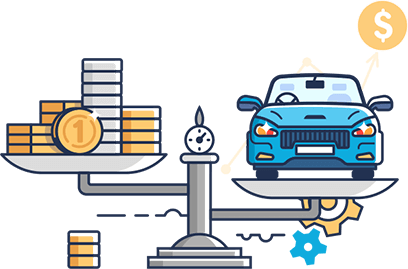
Trading in a vehicle is considered part of the typical life-cycle for everyone’s set of wheels. That said, knowing when to trade your car in can significantly change the outcome for better or worse.
The “when” here refers to the point in time when dealerships will not only accept your vehicle, but also offer you “top dollar” for it.
Most dealers will low-ball their offer when you’re trading in, then turn around and sell your vehicle for marked-up price; this is how they make a nice profit off of your vehicle.
Furthermore, these dealerships do not want to purchase a car that they know will be sitting on the lot for an extended period of time.
This influences which cars they deem acceptable for a trade in and, therefore, which impacts when it’s the best time to trade your vehicle.
Our expert evaluators can help you get an accurate estimate for your car's value, FAST!

The Best Time To Trade In Your Car
When The Mileage Is Low
Mileage is a critical determining factor when calculating car depreciation. When you visit a dealership to trade in your vehicle, the odometer reading will be one of the first things evaluated before the dealership accepts it.
Every mile a car travels increases the amount of wear and tear on the vehicle’s crucial components. These include, but aren’t limited to: tires, brake pads, and flywheel.
Furthermore, every mile you drive speeds up the meeting between your engine and the grim reaper. Usually, vehicles with more miles will have a lower resale value than an identical make and model with lower mileage.
A low-mileage vehicle is (statistically speaking) less likely to experience technical issues in the immediate future than high-mileage ones.
With that in mind, dealerships shape their offer and prefer low-mileage vehicles as trade-ins.
Fun Fact: While mileage directly impacts your trade in offer, your service record holds some serious weight as well.
A car with 100,000 miles on it and a perfect service record may fetch a better trade in offer than the same car with 70,000 miles on it.

When You Have Equity On Your Car
Equity (in regards to your car) is the difference between how much you owe on your car and its current market value and it can be either positive or negative.
Positive equity simply means that after you sell the car and pay off the loan, you would still have some money remaining.
Negative equity, however, means the current value of your car would not pay off your outstanding loan.
If your car depreciates faster than you can pay off the loan, you may find yourself with negative equity (aka being upside down on your loan).
Trading in your vehicle while you have equity on it is the most beneficial move for you. That extra money you have left after can be deducted from the price of your new vehicle.
NOTE: While it is possible to trade in a car with negative equity, it would immediately put you upside down on your new auto loan. Negative equity trade ins should be reserved for absolute necessities.
When Repairs Surpass Your Car Note
Being in and out of the mechanic is never a situation anyone wants to find themselves in. If you feel like you’re in a constant loop with the repair shop, then it may just be time to part ways with your car.
You’re likely putting more money into it than you’re spending on the monthly payments.
In order to figure out the current value of your car and weigh it against how much you’re spending on repairs, you’re going to get a quick evaluation with CarBrain.
You can have your car’s value within 90 seconds, completely free of charge.
It’s Always “When” With CarBrain

Trading in a car with CarBrain is always “right on time.”
With our cutting-edge valuation calculator, one of our associate buyers can provide you with the value of your vehicle within 90 seconds.
There’s zero-obligation and it’s absolutely free.
Should you accept that offer, they’ll connect you to one of the local service providers within our national network.
With our providers servicing the nation, there’s hardly anywhere we can’t reach your vehicle.
Schedule a tow in as little as 24-48 hours and a tow truck will be dispatched to come pick up that car — completely on the house!
After a brief inspection, the driver will hand you the amount that was promised — no haggling down or anything of that sort — and will take that car away in no time.
All this done without you leaving the convenience of your home.
Contact CarBrain today and let’s get started on getting rid of that car!



